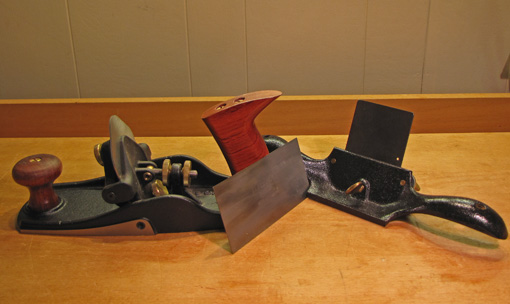I find myself using only two of the three scraping tools pictured here. The odd one out for me is the #80-type cabinet scraper, with the spokeshave-like wing handles. While there is a wide range of valid opinion on this subject, and a legion of other scraping tools, here are reasons for my preferences.
The humble card scraper is the ultimate in simplicity and utility in a woodworking tool. I use .024″ thick scrapers for general smoothing, and .020″ scrapers for more delicate or focal tasks. I keep a .032″ scraper for unusually heavy work but find it too tiring to bend for general work. I do not use scraper holders since they decrease the sensitive control of the tool in my hands. Since I am using the scrapers for finishing a surface, not dimensioning it, the card scraper works well on areas up to a small table top.
All of these scrapers are hardened to about Rc50. Lie-Nielsen, Bahco, and Lee Valley are fine brands. I keep a few .020″ x 1″ x 2″ mini scrapers (from Lee Valley) that are very handy for touch up work in restricted places. I also keep some softer .020″ scraper stock to easily file into special shapes. Gooseneck and curved scrapers complete the set.
The cabinet scraper’s main disadvantage is its short sole. It lacks both the handiness of the card scraper and the control of the scraper plane. Despite skewing techniques, I find it is unreliable at the beginning and end of boards, and has neither the finger tip control nor the steadiness to avoid occasional blade chatter. The one pictured is a fine quality tool that I’ve owned for over 20 years, and the aftermarket Hock blade is excellent, but it now mostly sits idle. I’ve briefly tried the Veritas model which has a slightly longer sole but it didn’t fly for me.
The folks at Veritas have, fortunately for us, a healthy obsession with scraping, and one product of this is their superb Scraping Plane which has a variable blade angle and the ability to bow the .055″ blade. I once owned a Kunz version but it lacked the ability to bow the blade. Lie-Nielsen makes a similarly large scraper plane, an excellent tool, but its much thicker blade is a different working approach which I found too fastidious to deal with.
With the Veritas, cutting depth is controlled with a combination of the blade angle and the amount of bow. Varying each of these also alters the cutting feel, useful for different woods. The large sole keeps the work flat and prevents digging in, while the tool’s mass helps avoid chatter.
After much experimenting, I find it easier and more effective to prepare the blade with a 90 degree edge (like a card scraper), contrary to the usual recommendation of 45 degrees for scraper planes. This seems to give a more solid, though less aggressive, cutting action, and is pleasingly reminiscent of a card scraper, but with the mass and registration of the big body plane.



Thanks for your excellent post on scrapers. In what situations do you use the LV scraping plane instead of the handheld scrapers?
Hi Amos,
The scraper plane works well for larger areas. It is less tiring on the fingers than a card scraper, it can be set up to take a more aggressive cut, and maintains a flat surface more reliably. It takes some trial and error to get comfortable with it but it’s a cool tool.
Rob
Hi Rob,
It is interesting to me that you work with a ninety degree edge on the scraper plane blade. What pushed you or gave you the idea to try it? I own the LN large scraper, and it is a fussy tool to get set just right. One thing that doesn’t happen, which used to with #80 scraper, is the snapping of the blade once it exits off the far edge of the board. Getting just the right angle and projection on the LN is surprisingly tricky. I wonder if a ninety degree edge is worth trying. What accounts for the handling difference, do you think, for a burr raised on a 45 versus a 90 degree edge?
Hi Tico,
It’s really a matter of personal preference, but I find the 45 degree edge too aggressive for smoothing. I also think the 90 degree edge is less prone to chatter. The 45 seems to “grab” the wood and sometimes gets distorted, whereas the 90 seems to hold a steadier cut. (I doubt a 90 edge would work with the thick L-N blade.)
Regarding the L-N, it is a well-made tool but I agree with your comments. Being able to bow the blade in the Veritas tool helps with sensitive depth adjustment and it pre-tensions the blade to reduce chatter.
Thanks for your comment.
Rob